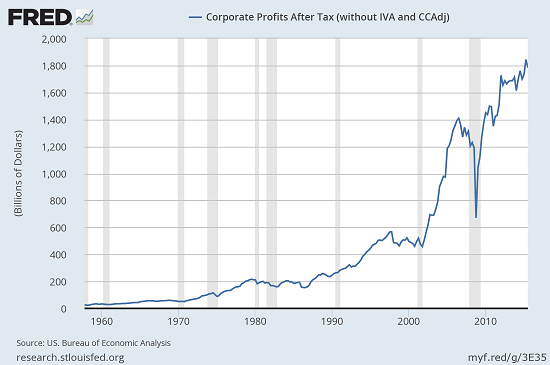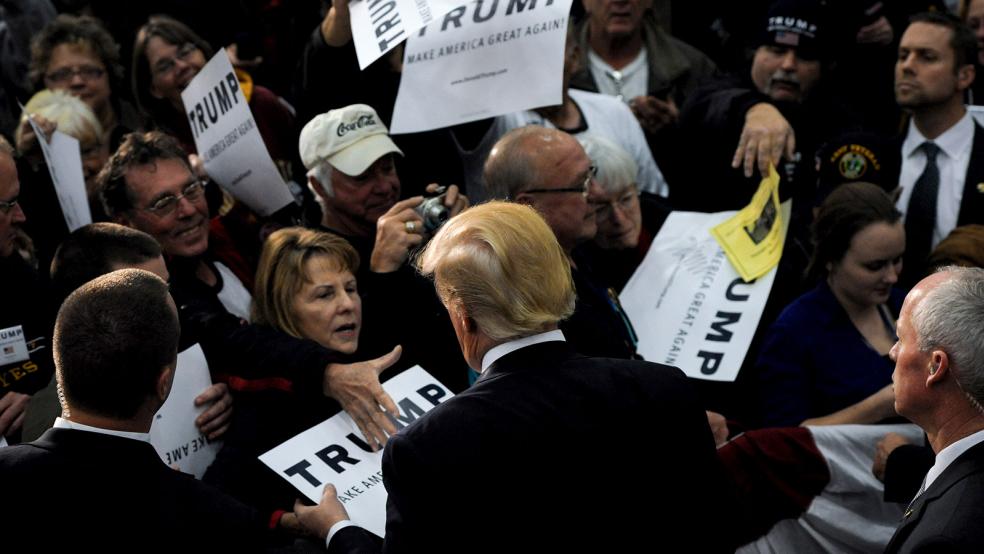Donald Trump is inching closer to securing the Republican presidential nomination as voters cast their ballots on Super Tuesday -- an outcome that has the donor/Establishment/media nexus apoplectic and social justice warrior types despondent.
Much has been said about Trump's look, language, demeanor, faith, fidelity to the conservative cause, stance on gun rights, women's rights, and so much more. He has been called every name in the book -- sexist, racist, bigot, fraud and fascist -- and compared with Hitler and Mussolini.
And yet his staying power cannot be dismissed. To my mind, it's not about banning Muslims or building walls. Trump’s rise is about his unique grasp of the most fundamental economic issue that's been hurting regular American workers for decades: the influx of foreign workers and the outflow of corporate capital expenditures that have reduced wage-raising bargaining power.
Related: Another Reason for Stagnant Wages: High Productivity
Trump is a guy who understands leverage in deal making. And he understands that basic supply-demand dynamics have undermined the ability of middle-class Americans to extract pay raises and keep pace with the persistent increase in the cost of living. And that's why his appeal has confounded the political pundits.
If his appeal was based on his language and bluster, America would have elevated someone like Howard Stern or Ann Coulter long ago. If his appeal was based on foreign policy concerns, why isn't a military general leading the charge? It's the economy, stupid! And the fact is that real, median household income peaked at nearly $58,000 back in 1999 and has been sliding ever since, standing now at just $53,657.


This can all be summarized in two charts: The relationship between corporate profitability and labor's share of income shown above.
Cheap laborers (both undocumented unskilled and skilled H1-B guest workers) and the ability to offshore production and reimport goods into the United States have boosted earnings to record highs. Yet in a mirror-image decline, the share of income going to Middle Americans has collapsed.
Politically, the backlash against this dynamic has been burning slowly for two reasons -- both of which can be traced to the ultra-easy monetary policy of the Federal Reserve over the past 20 some years.
First, easy money has fueled asset price appreciation, allowing Americans to tap home equity and stock market wealth to supplement stagnant wages and fuel their ability to spend. We saw this in the dot-com boom. We saw it in the housing bubble. And we've seen it again in the current bull market.
Unfortunately, the gain in household net worth has been largely relegated to the wealthy who overwhelmingly own the most financial assets -- fueling worries about rising inequality. (Check out page 30 of the Fed's Survey of Consumer Finances for more information.)
Second, many have turned to credit to pad stagnant incomes. Since 1999, household credit has grown from $6.6 trillion to more than $14 trillion.
But now, the political anger is white-hot. Trump thunders in his rallies -- which increasingly resemble rock concerts in mood and tone-- about Ford building factories in Mexico or IT workers from Disney being displaced by foreigners they are forced to train.
Related: Hillary Endorsed Trade Pact 45 Times at State – and Flip-Flopped
Americans used to be content with this arrangement, buying suddenly cheaper imported goods with wealth and credit. But with homes filled with electronic toys, furniture and clothes, we now want our economic security back. Even mainstream economists are starting to concede that open trade has depressed American wages. The worm is turning.
The surprising enthusiasm for Democratic presidential challenger Bernie Sanders can also be explained by these dynamics -- especially his appeal to younger voters burdened by debts (mainly, student loans) and without the capital assets (homes, retirement accounts) needed to benefit from the Fed's asset inflation focus. He rails against Wall Street (the creditors). He rails against the rich (benefiting the most from the Fed). And he rails against corporate profits.
But where Sanders and Trump differs -- and why Trump has had more success -- is that their policy prescriptions are different.
Sanders wants to treat the symptoms with palliatives like increased taxes and regulation, using the power of the U.S. government to redistribute wealth from the rich and the corporate sector to poor and middle-income Americans at the risk of further damaging America's potential growth rate by reducing entrepreneurship and economic dynamism.
Trump is talking about attacking the root cause of the problem: Elevating free trade and corporate globalism over American nationalism and "fair" trade.
For all the looking-down-the-nose belittling of Trump supporters as low-information voters, they implicitly understand this profound truth and realize that -- with Establishment candidates in both political parties beholden to the status quo -- the ostentatious Manhattanite with ridiculous hair and no brain-to-mouth filter is best positioned to turn things around.
Anthony Mirhaydari is founder of the Edge and Edge Pro investment advisory newsletters. A two-week and four-week free trial offer has been extended to Fiscal Times readers.






